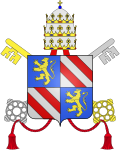Pope Pius IX
Blessed Pius IX | |
|---|---|
 | |
| Papacy began | June 16, 1846 |
| Papacy ended | 7 February, 1878 |
| Predecessor | Pope Gregory XVI |
| Successor | Pope Leo XIII |
| Personal details | |
| Birth name | Giovanni Maria Mastai-Feretti |
| Born | May 31, 1792 Senigallia, Marche, Papal States |
| Died | February 7, 1878 (aged 85) Apostolic Palace, Vatican City |
| Motto | Crux de Cruce |
| Other popes named Pius | |
Pope Pius IX (Latin: Pius PP. IX, Italian: Pio IX; May 13, 1792 – February 7, 1878), born Giovanni Maria Mastai-Feretti, was an Italian priest of the Roman Catholic Church and the 256th Pope, from 1846 until his death.[1] Only Saint Peter himself led the church longer than the 32-year reign of Pius IX.
In 2000, he was beatified, which is a step in the process of naming a saint of the Catholic Church.[2]
Career[change | change source]
Mastai-Feretti was ordained as a priest in 1819.[3]
Bishop[change | change source]
Father Mastai-Feretti was named Bishop of Spoleto in 1827.[3] In 1877, the Golden Jubilee celebrations recalled the 50 years since he was named a bishop.[4]
Cardinal[change | change source]
In 1840, Pope Gregory XVI made Bishop Mastai-Feretti a cardinal.[3]
Pope[change | change source]
Cardinal Mastai-Feretti was elected Pope in 1846; and he took the name Pius IX.[3]
In 1846, Piux IX declared an amnesty for political prisoners.[2]
In 1848 he ordered that the gates to the Jewish ghetto in Rome be knocked down.[2]
Pius formally defined the dogma of the Immaculate Conception.[5]
Papal States[change | change source]
In 1849, Pius was deposed as the temporal ruler of the Papal States.[3] As a result of Italian nationalism and the Risorgimento, the Papal States and all of the pope's land outside the Apostolic Palace were seized in 1870 and pope spent his last years a virtual prisoner within the Vatican.[2]
First Vatican Council[change | change source]
In 1869-1870, Pope Pius brought together the church's bishops and cardinals in a meeting called the Vatican Council.[6] The council defined the dogma of papal infallibility.[7]
Pius died at age 85.[8]
After his death[change | change source]
The process of recognizing Pius IX as a saint began in 1907.[2]
The body of Pope Pius IX was exhumed in 1956.[9] This was part of a ceremony of "recognition".[5]
Preparations for beatification were almost finished in 1962;[10] and they were completed in 1984.[2]
Related pages[change | change source]
References[change | change source]

- ↑ "List of Popes," Catholic Encyclopedia (2009); retrieved 2011-11-02.
- ↑ 2.0 2.1 2.2 2.3 2.4 2.5 Stanley, Alessandra. "Italian Jews Denounce Vatican's Decision to Beatify Pius IX," New York Times. 28 June 2000; retrieved 2013-3-18.
- ↑ 3.0 3.1 3.2 3.3 3.4 "Pope Pius IX," Catholic Encyclopedia; retrieved 2011-10-28.
- ↑ "The Papal Golden Jubilee," New York Times. June 4, 1877; retrieved 2011-10-30.
- ↑ 5.0 5.1 "Pius IX 'Recognized'; Step Toward the Beatification of 19th Century Pope Taken," New York Times. November 20, 1956; retrieved 2011-10-30.
- ↑ "Vatican Council," Catholic Encyclopedia; retrieved 2011-10-28.
- ↑ "Papal Infallibility; What Pius IX. Himself is Credited With Saying," New York Times. August 9, 1871; retrieved 2011-10-30.
- ↑ "Pius IX," New York Times. February 8, 1878; retrieved 2011-10-30.
- ↑ "Body of Pope Pius IX Exhumed in Ceremony," New York Times." October 26, 1956; retrieved 2011-10-30.
- ↑ "Pope Plans October Decree Of Beatification of Pius IX," New York Times. August 22, 1962; retrieved 2011-1101.
More reading[change | change source]
- Kertazer, David I. (1997). The Kidnapping of Edgardo Mortara. New York: Knopf. ISBN 9780679450313; ISBN 9780679768173; OCLC 35829023
Other websites[change | change source]
![]() Media related to Pius IX at Wikimedia Commons
Media related to Pius IX at Wikimedia Commons
 . Catholic Encyclopedia. New York: Robert Appleton Company. 1913.
. Catholic Encyclopedia. New York: Robert Appleton Company. 1913.- Catholic Hierarchy, Pope Pius IX
- Cardinals of the Holy Roman Church, Cardinal Mastai-Feretti
| Preceded by Gregory XVI |
Pope 1846–1978 |
Succeeded by Leo XIII |
